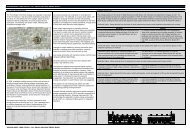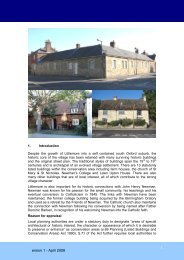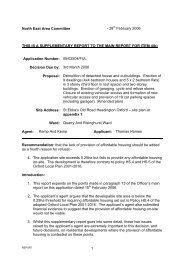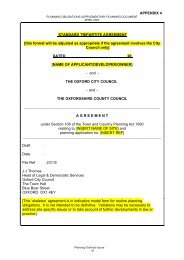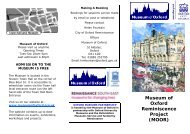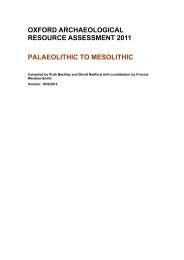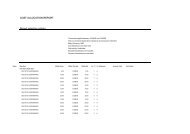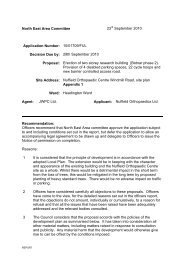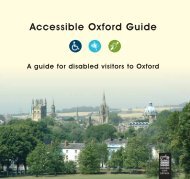Post-medieval Oxford - Oxford City Council
Post-medieval Oxford - Oxford City Council
Post-medieval Oxford - Oxford City Council
You also want an ePaper? Increase the reach of your titles
YUMPU automatically turns print PDFs into web optimized ePapers that Google loves.
o Material from the construction of the 18th century north quadrangle at<br />
Queens (trial trench)<br />
o Real Tennis Courts at Oriel (excavation)<br />
o 17th century food waste from Oriel College (excavation?)<br />
Burial grounds and cemeteries<br />
o Wellington Square Workhouse Burials (excavation?)<br />
o Radcliffe Infirmary Burial Ground (evaluation)<br />
o St Clements Church Graveyard (watching brief)<br />
o St Peter at the Bailey Church Yard (excavation)<br />
o Castle Prison burial ground (excavation)<br />
Thames<br />
o Binsey Boat – working boat or punt (excavation)<br />
Chronology<br />
<strong>Oxford</strong> experienced the Dissolution of the Monasteries after a long period of<br />
economic decline. By 1540 it ranked only 29 th amongst English Towns in terms of its<br />
taxable wealth. The town was granted the status of a city when the see of <strong>Oxford</strong><br />
was created in 1542 but stagnation continued until c1580, when the expansion of the<br />
university stimulated growth (Stone ed.1974). The dynamics of growth can be seen<br />
by comparing Agas’ 1578 map of <strong>Oxford</strong> with the maps of Hollar and Loggan from<br />
the 17th century. The university and colleges expanded by appropriating tenement<br />
blocks in the east end of the walled town and in the suburbs. By the end of this<br />
period, these buildings dominated the landscape in the west end of the walled city<br />
and in the northern suburbs. The city recovered well from the destruction of the Civil<br />
War and by 1662, <strong>Oxford</strong> ranked eighth amongst English provincial towns on the<br />
basis of the hearth-tax assessments. However, in the later 17th century, the<br />
university entered a period of decline. In the 18th century, <strong>Oxford</strong>'s population fell<br />
slightly, although the town was becoming increasingly renowned for the architectural<br />
achievements of the University and Colleges (VCH iv).<br />
<strong>Oxford</strong> is well documented and mapped during this period resulting in broadly good<br />
chronological frameworks, although this is less the case for rural areas. This means<br />
that chronology and dating should be better understood than for earlier periods,<br />
however, opportunities to obtain reliable dates for structures or landscapes element<br />
are still extremely valuable. The regional research frameworks note that the reliability<br />
of chronological markers, particularly for the 16th-18th centuries, needs to be tested.<br />
There is considerable scope to use dendro-chronology to test architectural<br />
typologies. The ceramic sequence is reasonably developed, but should be further<br />
tested.<br />
OXFORD ARCHAEOLOGICAL RESOURCE ASSESSMENT- POST MEDIEVAL<br />
9



